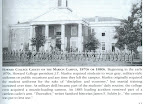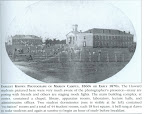
This earliest known image of the Marion campus of Howard College is post-Civil War and appears to show students in civilian dress (Samford University Special Collection).

(Both images are from 160 Years of Samford University: For God, For Learning, Forever (Arcadia, 2001) by Sean Flynt.)
Based on what I have read to date, I have found little to substantiate any of the above claims! It appears that Howard College, MMI’s predecessor, remained open during part of the war, at least, but that the college was non-military (if not Confederate in spirit!). Yes, the Confederate Breckinridge Military Hospital utilized the campus in 1863-1865, and Federal troops entered the town of Marion in 1865. However, there is no mention of the Howard College Cadet Corps participating in any of this; perhaps, because they were non-existent!
James F. Sulzby’s two-volume Toward a History of Samford University (Samford University Press, 1986) makes no mention of Howard College students (Samford’s former name) fighting as a cadet unit in any engagements.
That Howard College alumni did fight bravely as members of various volunteer Confederate units is a given. Simply put, nearly every able-bodied male (including many boys) served in the Confederate forces. Even one of Marion’s Confederate generals, BG George D. Johnston, was a Howard College graduate.
With the outbreak of hostilities in 1861, Howard College students joined the Marion Rifles, Marion Light Infantry, and several other volunteer Confederate units. The president of Howard College, Dr. Henry Talbird, formed his own company, the Independent Company, which consisted mainly of “Howard students and boys from the vicinity.” Captain Talbird’s company was absorbed into the regular Confederate forces and they did fight bravely in the Virginia theatre of operations.
In the 1950s a cadet delivered an address in The Chapel on the history of MMI.:
“His [Union General James H. Wilson] next stop was the Confederate arsenal at Selma. His success was not immediate, for he was opposed by the cadets of Howard College, which is now Marion Institute. The cadets stood as long as possible in one of the bloodiest battles of the war, then retreated to Marion, the birth place of the Confederate flag. After the battle the wounded of both sides were brought in by trains and horse-drawn carts to the hastily prepared hospital in South Barracks. Approximately eighty Confederates and twenty Yankees died, and they are buried in the Episcopal cemetery in Marion. Many of the tombstones are marked unknown, and they stand in silent tribute to those soldiers of the Blue and Grey Armies that left their homes never to return again.”
This report, however erroneous, enjoyed some distribution, at least (I have several copies in the Archives). Unfortunately, future writers of MMI history picked up on this report and went with it so that today the truth is shrouded in myth and fable.
Some of the confusion about Howard College during the Civil War may stem from other Southern educational institutions which did fight as units at various points during the war. The Citadel (South Carolina Military Academy) and Virginia Military Institute leap to mind. So does the University of Alabama Corps of Cadets (their commandant, COL James T. Murfee, became the founder and first president of Marion Military Institute). Other schools include Georgia Military Institute and the (West) Florida Military and Collegiate Institute, among others.
The John Ford-John Wayne movie, The Horse Soldiers (1959), depicts the cadets of Jefferson Military Academy harrassing Union cavalry. While JMA actually existed in Washington, Mississippi, near Natchez (it was called Jefferson College during the war, was very similar to Howard College, and was essentially closed), the cadet scenes for the movie were fabricated as a tribute to Virginia Military Institute and their charge at the Battle of New Market, VA, on May 15, 1864.
“Youth’s Hour of Glory” by Tom Lovell (New Market):

The site of Jefferson Military Academy today is Historic Jefferson College (1811-1964), a Mississippi state historical landmark.

Hopefully, this short piece will shed some light on the subject and will help to dash some of the myth and fable surrounding MMI.
Finally, someone told me once in Virginia that they knew exactly who had shot Confederate General Thomas J. “Stonewall” Jackson; that the shooter was a relative of theirs, and that the shooting was in revenge for one of Jackson’s misdeeds! Here we go again!